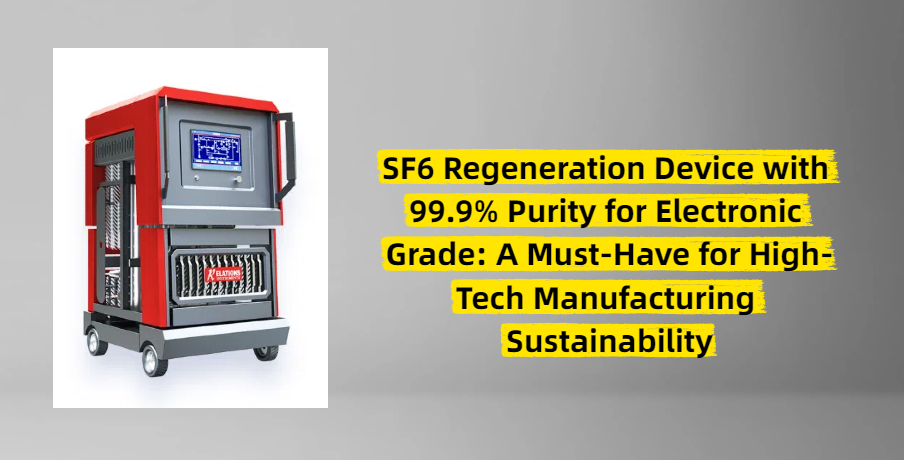
SF6 Regeneration Device with 99.9% Purity for Electronic Grade
For the electronic industry—from semiconductor wafer fabrication to photovoltaic (PV) cell production—SF6 (sulfur hexafluoride) is an indispensable specialty gas, used primarily for etching, insulation, and cleaning processes. However, SF6 is one of the most potent greenhouse gases, with a global warming potential (GWP) 23,900 times that of CO₂ over 100 years. This dual challenge—critical operational need vs. strict environmental regulations—has made an SF6 regeneration device with 99.9% purity for electronic grade a non-negotiable solution for forward-thinking manufacturers.
Why 99.9% Purity Is Non-Negotiable for Electronic-Grade SF6
Electronic manufacturing demands ultra-high precision, and even trace impurities in SF6 can derail production. For semiconductor chips, SF6 acts as a key etching gas to create microscopic circuits; impurities like moisture, sulfur dioxide (SO₂), or particulate matter can cause “pinholes” on wafer surfaces, reducing chip yield by up to 15% (per industry data). Similarly, in PV cell production, impure SF6 disrupts the deposition of thin-film layers, leading to lower energy conversion efficiency.
99.9% purity is the industry’s gold standard for electronic-grade SF6: it eliminates almost all contaminants that harm product quality, ensuring consistent performance across semiconductor, display panel, and electronic component manufacturing. Unlike low-purity regenerated SF6 (common in power utilities), electronic-grade devices must target this exact purity threshold to meet ISO 10462-1 and SEMI standards—requirements no modern electronics plant can ignore.
How SF6 Regeneration Devices Achieve 99.9% Electronic-Grade Purity
The best SF6 regeneration devices for electronic use rely on a three-stage precision process to strip impurities while preserving SF6’s chemical stability:
- Pre-Treatment Filtration: First, the device removes large particles (≥0.1μm) and free moisture using high-efficiency HEPA filters and desiccants. This step prevents clogging in downstream systems and avoids hydrolysis of SF6 (which forms corrosive byproducts).
- Adsorption Purification: Next, specialized molecular sieves and activated alumina adsorb trace contaminants—including SO₂, H₂S, and carbon tetrafluoride (CF₄)—that affect electronic processes. These adsorbents are tailored for electronic-grade needs, ensuring no residual particles leach into the final gas.
- Precision Distillation: The final stage uses temperature-controlled 精馏 (rectification) to separate low-boiling-point impurities from SF6. By maintaining a stable column temperature (around -63°C, SF6’s boiling point), the device isolates pure SF6 vapor, which is then condensed and stored—achieving the 99.9% purity benchmark.
Advanced models also include real-time purity monitors (using gas chromatography) to alert operators if levels drop, ensuring zero compromise on quality.
The Triple Value of Electronic-Grade SF6 Regeneration Devices
Beyond meeting purity requirements, these devices solve three core pain points for electronic manufacturers:
- Environmental Compliance: By regenerating and reusing SF6 (instead of venting it), manufacturers cut emissions by 90% or more—aligning with EU ETS, U.S. EPA SNAP, and China’s “Dual Carbon” goals. This avoids costly fines for non-compliance (which can exceed $100,000 annually for large plants).
- Cost Savings: New electronic-grade SF6 costs $500–$800 per kg; regenerating used gas reduces this expense by 60–70%. For a mid-sized semiconductor plant using 500 kg of SF6 yearly, this translates to $150,000–$200,000 in annual savings.
- Supply Chain Stability: Global SF6 shortages (driven by production limits) have disrupted electronics manufacturing in recent years. A regeneration device creates an on-site “closed-loop” system, eliminating reliance on volatile external suppliers.
Key Applications Across the Electronic Industry
The versatility of 99.9% purity SF6 regeneration devices makes them essential for:
- Semiconductor Wafer Fabrication: Etching of silicon wafers for logic chips and memory devices (e.g., DRAM, NAND).
- PV Cell Production: Cleaning and passivating solar cell surfaces to boost energy output.
- Flat-Panel Displays: Insulation in plasma display panel (PDP) manufacturing and etching for OLED substrates.
- Electronic Component Testing: Providing inert atmospheres for testing high-voltage capacitors and sensors.
Conclusion: The Future of Electronic Manufacturing Is Regenerated SF6
As electronic manufacturers race to produce smaller, more powerful chips and sustainable PV cells, the need for an SF6 regeneration device with 99.9% purity for electronic grade will only grow. It is no longer just an environmental tool—it is a strategic asset that improves yield, cuts costs, and ensures compliance. For businesses looking to stay competitive in a low-carbon, high-precision industry, investing in this technology is not an option—it is a necessity.

